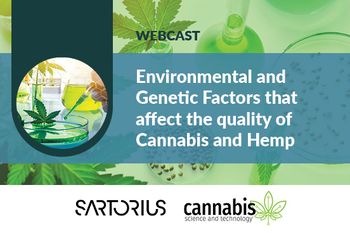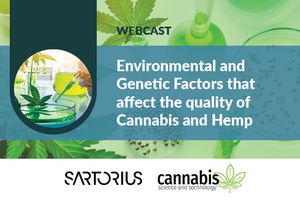
In this study, Sartorius Optifit tips and Safetyspace™ Filter tips were tested not to leach compounds of interest for cannabis quality control such as arsenic, cadmium, mercury, lead, or pesticides.

In this study, Sartorius Optifit tips and Safetyspace™ Filter tips were tested not to leach compounds of interest for cannabis quality control such as arsenic, cadmium, mercury, lead, or pesticides.


***Live Date: Tuesday, November 3, 2020 at 11am EST| 8am PST| 4pm GMT| 5pm CET*** Learn how the expression of various cannabinoids, terpenes, and flavonoids is affected by numerous environmental factors, and how analytical chemistry can help guide to development of novel genetics. ***On demand available after final airing until Nov. 3, 2021

Contaminants from common plastic labware can interfere with quality and potency testing by HPLC or GC-MS and heavy metal testing by ICP-MS.

This application note demonstrates the removal of particles in cannabis extracts with sample preparation prior to HPLC analysis.





Patient and consumer safety is a critical factor during manufacturing of your products. In addition, false test results in product quality testing can lead to unnecessary scrapping of batches and product recalls. Good pipetting practices using filtered and pure pipette tips help ensure contamination-free pipetting to prevent contamination during sample preparation, ensuring true test results and patient and consumer safety

Cannabis is medicine and it should be tested like medicine. This means the cannabis industry needs to adopt the pharmaceutical industry testing paradigm of cradle to grave testing. This webcast will discuss the technologies available for in-house testing, and how it can increase profitability and reduce compliance failures. Live: Wednesday, Nov. 20, 2019 at 11am EST | 8am PST | 4pm GMT | 5pm CETOn demand available after airing until Nov. 20, 2020.

Patient and consumer safety is a critical factor during manufacturing of your products. In addition, false test results in product quality testing can lead to unnecessary scrapping of batches and product recalls. Good pipetting practices using filtered and pure pipette tips help ensure contamination-free pipetting to prevent contamination during sample preparation, ensuring true test results and patient and consumer safety

Preventing contamination in pipetting is paramount to achieving reliable results. It requires identification of the potential contamination mechanism in order that they can all be addressed. This paper addresses the three contamination types that originate from pipetting: Pipette-to-sample contamination, sample-to-pipette contamination, and sample-to-sample contamination. Keep in mind: If your testing procedure in your Cannabis environment requires you to repeatedly portion out exact volumes of liquids involved, our bottle-top dispensers will give you a steady hand to ensure accurate and consistent results.

Improving your HPLC Sample Preparation is easier than ever with the Sartorius Cubis® MSA Dosing System. The Cubis MSA individual system with Q-App software automatically corrects the solvent volume to the appropriate value, eliminating the need to reach the precise target weight. At the end of the procedure, the weight of the compound(s) and solvents is used to calculate the verified concentration(s) and the verified volume of the standard prepared.

We tested the novel filter device Claristep® for the preparation of protein samples containing one of four different target molecules: an anti-malaria vaccine candidate, aviscuminum, interferon alfa-2B, or monoclonal antibody (mAb) P2G12. In comparison to the standard protocols for sample preparation prior to analysis by either reversed-phase or SEC HPLC, the Claristep® filter did not exhibit a significant difference in protein concentration if the target molecules were present with at least 1.0 g L-1. A significantly reduced product concentration was observed in the Claristep® filtered samples compared to the standard protocol for mAb P2G12 if the concentrations were lower. The protein adsorption to the filter material was well described by a Langmuir adsorption isotherm. Additionally, the Claristep® filters facilitated a rapid sample preparation with minimal volume losses.

The two-fold objective of this study was to 1) demonstrate that aqueous mobile phase preparations from purchased lab grade bottled water yielded comparable results to in-house prepared water (Sartorius Arium purified water Type 1 and Type 3) and that 2) using filters (Sartorius Minisart RC, SRP, NY & NY Plus, all 0.2 µm) yielded comparable results to unfiltered specimens under the same mobile phase conditions.






Published: October 27th 2020 | Updated:

Published: May 31st 2019 | Updated:

Published: May 31st 2019 | Updated:

Published: May 31st 2019 | Updated:

Published: May 31st 2019 | Updated:

Published: May 31st 2019 | Updated: